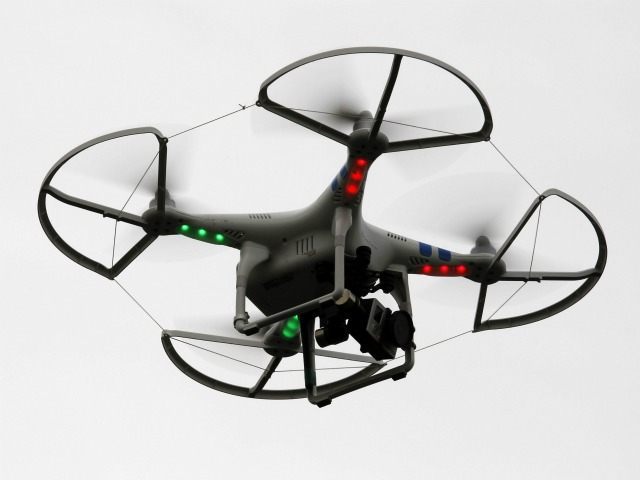Scientists at the Fusion Technology Lab at UW-Wisconsin have developed miniaturized bomb-sniffing technology that can be fitted to drones.
The detection technology, already used at airports to scan luggage and shipping containers, can detect dangerous materials such as chemicals, explosives, and drugs. Using a fusion device, a target area is painted with neutrons. Sensors then look for gamma rays or other signatures of harmful materials.
Led by Jerry Kulcinski, Emeritus Professor of Nuclear Engineering and Director of the Fusion Technology Lab, a group of grad students have successfully miniaturized a neutron source small enough to be mounted on a drone. In order to eliminate the drone’s need for a power source on the ground, the students used rectennas, a new and extremely efficient power source that converts electromagnetic energy, to beam energy to the neutron source using radio waves. The rectennas also eliminated the heavy battery packs used on the drones, which limited flying time.
While there are early concerns about its use of radiation, Kulcinski assures absorption amounts would be minimal. An hour of exposure in the target area would roughly equal that of 10 minutes on an airplane flying at 30,000 feet.
The possibilities for this technology in both military and civilian applications are “only limited by the imagination of the user,” says Col. John W. Weidner. Weidner works with the U.S. Department of Energy’s National Nuclear Security Administration to manage the country’s nuclear weapons stockpile.
“In a very practical manner, I think this can be a tremendous tool,” he says. “I see all sorts of different opportunities if this can be adopted by the appropriate agencies in our government.”
Weidner, who has received degrees in nuclear engineering and medical physics from UW-Madison, also expects the technology to be less expensive than the methods currently used by U.S. military and law enforcement agencies. In place of deploying expensive vehicles to identify and detonate explosives, the authorities could “fly a drone over it, irradiate it and find out it’s full of flour,” postulates Weidner.
Capable of detecting buried explosives, it could be used to alert soldiers of nearby IEDs. In addition, it could assist authorities in the removal of nearly 50 million land mines scattered throughout 60 different countries, which kill about 10,000 individuals annually.
Civilian uses are just as plentiful. Rescuers can be directed to victims buried in rubble from explosions or natural disaster, such as an earthquake or a mine collapse. The drones can be used to map mineral deposits in areas unreachable by humans, such as mountains or deep valleys. There is even potential to acquire new energy sources through lunar prospecting.
Using the technology in stationary areas that may be attractive to terrorists such as airports, tourist areas, and large public events could help authorities to prevent attacks. “If we had a low-intensity neutron source in that hall at the Brussels airport, we could have detected those bombs without hurting anybody,” says Kulcinski. Japan is looking to implement the technology to strengthen security for the 2020 Olympics, focusing on detecting backpack explosives.
While the possibilities abound, the technology has some limitations to its capabilities. At this point, the miniaturized fusion source can only detect explosives located less than three to six feet underground. Kulcinski recognizes that there will be attempts to circumvent the drones. “One of the ways to get around the drones is to bury (explosives) very deep, but if you bury them very deep they won’t create the damage they’d create if they were a foot or so below the ground,” he says. “So if you can get the bad guys to bury everything six feet down, then you’re making some progress.”
In addition, due to the necessity of drones to fly relatively low to the ground, the internationally renowned scientist expects some to be shot down within combat areas. “It’ll be like being at a duck hunt,” says the professor. “That’s going to happen. But if the bad guys are shooting them down, you know that’s an indication that there are problems in that area to worry about, and you act accordingly.”
The scientists have also found that the neutron source slows down when it passes through hydrogen, effectively neutralizing the technology. The discovery was made when the U.S. Navy sought to use the drones to find deep underwater mines.
But perhaps the biggest challenge at hand is the drones’ difficulty detecting certain materials, including the ability to locate lead- or steel-shielded nuclear weapons. Matthew McKinzie, a nuclear physicist of the Natural Resources Defense Council, explains:
Detection of illicit materials is a really difficult problem, especially for the most dangerous nuclear material, which is highly enriched uranium. The radiation signal can be concealed very effectively. And an improvised nuclear device, a terrorist’s nuclear weapon, can be made most simply with highly enriched uranium.
Aside from its current limitations, it may not be too long before the technology is available for use in the field. Professor Kulcinski, who is a longtime adviser for NASA, believes that it will take about a year — if they can find a source willing to either buy it or fund it to completion. Weidner also believes that a demonstration of the technology, perhaps financed by a government agency, could lead to a private interest, such as a drone manufacturer, purchasing it. “If they can get their first customer, I think that’s what it will take for it to take off,” said Weidner.
Until then, it seems Hulsok Heng will have pretty solid job security.

COMMENTS
Please let us know if you're having issues with commenting.